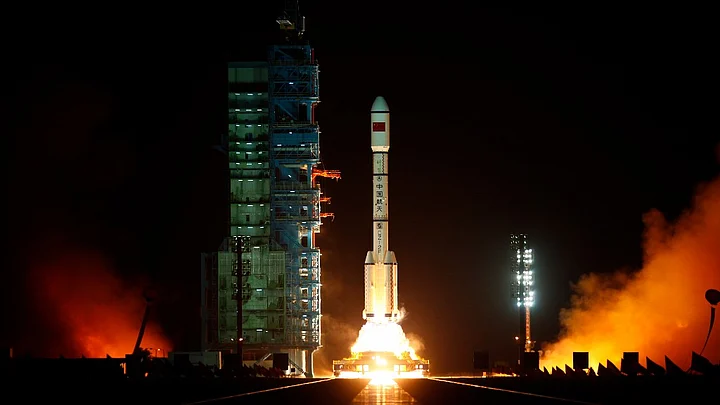Tiangong-1, a Chinese space laboratory that was launched on 30 September 2011 – ceased to function in March 2016, while China lost control of the spacelab the same year in June. Now, two years later, that spacelab is said to make an uncontrolled re-entry into the Earth’s atmosphere.
But when this is going to happen, and where the parts will fall is a matter of huge speculation, with latest reports suggesting that it will may fall back between 31 March and 1 April (+/- 16 hours).
An international group called the Inter-Agency Space Debris Coordination Committee is conducting a campaign to monitor Tiangong-1’s re-entry. The experts on the committee belong to 13 organisations, including our very own ISRO, NASA and the European Space Agency.
Tinagong-1’s fall can be tracked here.
What is Tiangong-1?
Tiangong means ‘heavenly palace’. It is a spacelab, or in common parlance, a spacecraft capable of supporting crew members, and designed to remain in space (mostly as an artificial satellite) for an extended period of time and for works for other spacecrafts as a dock.
Tiangong-1 was launched by China as a prototype for a permanent space station.
Tiangong-1 was a highly advanced spacelab, equipped with earth observation instrumentation and space environment detectors. It weighs 8.5 metric tonnes and is about 34 feet long and 11 feet wide. It has two solar panels, which measure approximately 23x10 feet.
Tiangong-1 had obtained a decent amount of application and science data. For example, it had collected images of an Australian forest fire.
What's the Worry Now?
China losing control of Tiangong-1 is a matter of concern as the spacelab – which is currently out of human control – is said to fall back to the Earth anytime soon.
China had predicted in September 2016 that Tiangong-1 would re-enter the atmosphere in the later half of 2017. However, latest reports say that it is likely to happen between 31 march and 1 April (+/- 16 hours).
As per orbital data gathered by Space.com from TS Kelso, a senior research astrodynamicist at the Center for Space Standards and Innovation, the spacelab has been dropping slowly in altitude – from 225 miles in the beginning of 2017, to about 193 miles as of October 2017. It is dropping at a daily rate of approximately 160 metres. At this rate, the spacelab’s re-entry was said to be anytime between October 2017 and April 2018. However, according to US based Aerospace corporation’s latest tracking, Tiangong-1 was about 178 kilometres away from Earth on 30 March as of 3:30 pm (IST), with an estimated ETA of approximately 48 hours (+/- 16 hours).
Is the Crash Going to Be a Danger?
While the exact date, time and place of the crash is not known, it is said that the vehicle will re-enter earth somewhere between 43 degrees north and 43 degrees south latitude. This is as vague as it gets. These coordinates cross through Europe, the Mediterranean Sea, Asia, the Pacific Ocean, North America, and the Atlantic Ocean, the Indian Ocean, Australasia, the Pacific Ocean and South America.
There have been voices of concern regarding this crash, around whether it will cause any damage to human civilisation or property due to the sheer size and the massive weight of the object.
Although most authorities say that it is unlikely that the crash will harm anyone or anything because two-thirds of the Earth’s surface is covered with water, it is still uncertain whether it should be considered a hazard.
"It could be a really bad day if pieces of this came down in a populated area … but odds are, it will land in the ocean or in an unpopulated area," Thomas Dorman, an amateur satellite tracker who has been tracking Tiangong-1 from Texas since its 2011 launch told Space.com.
But remember – sometimes, the odds just do not work out, so this may bear watching.Thomas Dorman
Earlier this year, the United Nations Office for Outer Space Affairs (UNOOSA) reissued a notification by China saying, “The chances of it endangering and causing damage is very low".
The possibilities that there will be harmful space debris left behind in outer space or the “toxic and corrosive fuel” on board will cause damage to the outer space environment and Earth’s atmosphere have also not been ruled out.
What are the Precautionary Measures?
China is said to be beefing up monitoring and calculations, and making arrangements to track the spacelab.
The California-headquartered Aerospace Corporation will also perform a Tiangong-1 risk calculation for both people and property a few weeks prior to re-entry.
"It is unlikely that this will be a controlled re-entry," the Aerospace Corporation website said.
Modelling work done by Aerospace Corporation in October 2017 shows the Tiangong-1 about 178 kilometres away from Earth as on 30 March.
What is Expected?
Detailed projected re-entry regions were to be provided just a few days before the re-entry time frame. Visibly luminescent objects from this re-entry will likely last tens of seconds. It may appear as multiple bright streaks moving across the sky in the same direction. It’s expected that most parts of Tiangong-1 will burn up during re-entry while some heavy parts, like the rocket engines, possess the density to survive the fall more or less intact.
The Tiangong-1 crash won’t be first of such incidents. In 1978, radioactive fragments from Russian nuclear satellite Kosmos 954 dropped into northern Canada. Another such instance was the large pieces from America’s first space station, Skylab, dropping shrapnel into the Australian outback, with larger pieces leaving scorched craters.
(This article was originally published on 13 December 2017. It has been republished from The Quint's archives to include the latest developments in Tiangong-1’s re-entry.)
